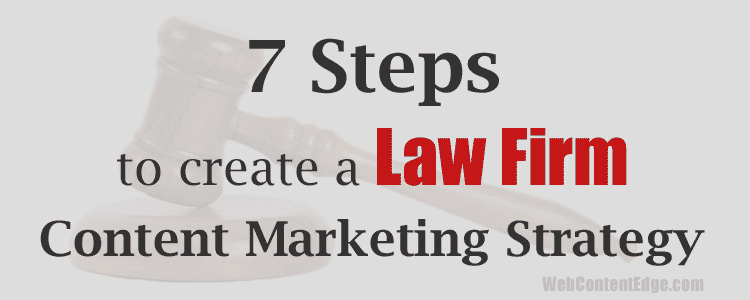Law Firm Content Marketing Strategy: This is the definitive guide to content marketing strategy for law firms.
Content marketing offers businesses an opportunity to boost their revenue with minimal resources. Content marketing can reap big results.
With both an organic and paid approach in the marketing of your content, you can reach your potential customers with ease. Not only do you make new customers but retain them with your educational content.
Due to the pandemic, making an offline in-person approach is futile. As not many people are eager to attend any physical event, online events have become the lifeline.
If you’re a lawyer prospecting clients, you need to have a strong online presence. And for that, it’s inevitable to have a content marketing strategy as a lawyer.
In this article, we’ll get through the main aspects of content marketing for lawyers. It might not be the best solution but at a time like this, you have to have a content-first strategy for acquiring clients.
What Is Content Marketing?
At Web Content Edge: we define content marketing as:
“Content marketing is a strategic marketing approach that involves regularly creating and distributing highly relevant, educational content for your target audience.”
The above definition is concise. It means that you need to create educational content for your potential clients. It has to address their pain points. Also, consistently provide useful content.
Content marketing isn’t direct sales. It’s all about building long-term relationships that ultimately lead to profitable customer actions.
Why content marketing for lawyers?
Surprisingly, not many lawyers think about content marketing to establish themselves as an authority in their law practice. In reality, as a lawyer, you can use your website and other social media channels to expand your influence.
From blog posts to YouTube videos, the social landscape is ever-expanding. If you’re not making use of it, you’re losing on a whole chunk of the unrealized market.
Today, almost every industry has some sort of content marketing strategy. To be precise, 84% of marketers have a content marketing strategy. And 82% of businesses are actively using “content marketing” as a part of their marketing strategy. Source: SEMRush
So, if you’re not one of those, you stand no chance of succeeding in this game.
Step-By-Step Guide to Content Marketing Strategy for Law Firms
1. Become A Great Storyteller
Storytelling is as old as cave paintings. In the ancient caves of France, you can find paintings of animals on the cave walls. These drawings are extraordinary, as they tell a story.

Photo by Don Pinnock on Unsplash
The purpose behind the paintings is to pass on knowledge to the next generation. It was a tool to provide visual aspects of storytelling. It aided in crucial communication. No wonder, the cave dwellers went so far in producing these magnificent arts.
Similarly, you too need to perfect the art of storytelling. Or hire someone with that ability. Crafting a story in your content will generate curiosity impacting engagement. Engaging content will result in high interactivity from your potential buyers. Generating a perpetual cycle of likes and shares.
If you decide to become a storyteller, you need to cultivate certain traits. One, you need to become a great reader. As a lawyer, you shouldn’t find it difficult. Read whatever your heart desires, but learn how the author embarks on a journey. Second, practice what you learn.
Storytelling is an art. Marketers need to put in a lot of time and effort. Reaping quick results isn’t easy, you need to learn from trial and error.
Starting with brand awareness, you need to tell a story. Brand storytelling to the rescue.
What Is Brand Storytelling?
According to Kaitlin Loyal on Scribewise, brand storytelling is “Using a narrative to connect your brand to customers, with a focus on linking what you stand for to the values you share with your customers.”
In a nutshell, brand storytelling is all about humanizing your brand.
If you want to have an impactful brand story, you need to look beyond your products and services.
Late Steve Jobs is a prime example of how to tell a story. He was a master storyteller. With words, he created magic. He took his company beyond selling products.
The idea was simple, Think Different. The carefully crafted message made Apple highly differentiated from its competitors. Almost to a point where it’s now competing with itself.
Such was his effect that people were spending the night in cold weather to get the best seat to his event. When Apple announced that Jobs won’t deliver his keynote presentation at Macworld Expo in 2009, there was an uproar amongst his fans.
The Jobs adept storyteller ability was so rousing that his audience was getting a dopamine hit. And would go on to protest his absence to get that hit again.
You don’t need to become Steve Jobs. But you need to learn how to become an effective storyteller. But if you can master it, you’ll turn your prospects into customers and finally into evangelists.
As a first-timer, it isn’t easy to tell a story. But by following a framework, you can create an impactful narrative. Look at the infographics on the story structure that you can use.
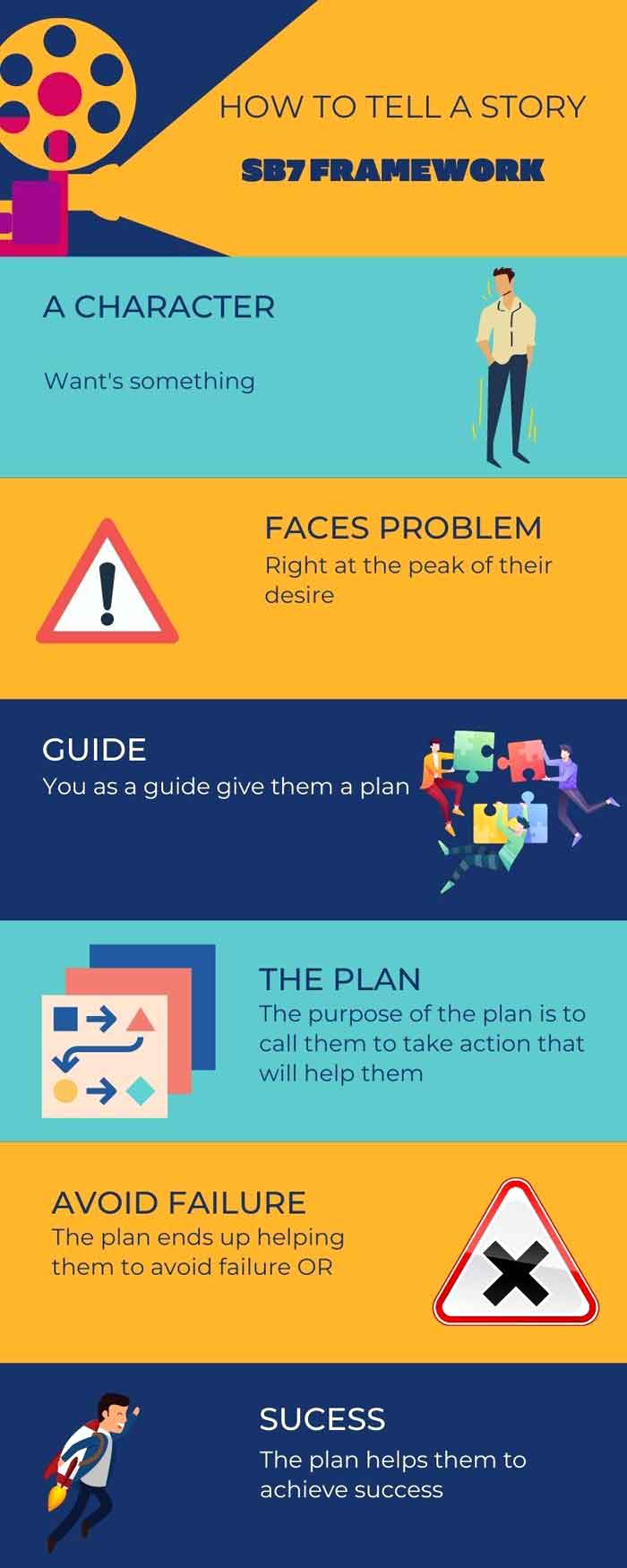
The SB7 framework by Donald Miller is a format to create your own brand story. Your objective is to give your audience an experience of how you can change their lives.
Here’s a rundown of the framework that you need to follow.
#1. A Character: The character here is your customer. The hero of your story. Many brands mistakenly think that they are the hero in customers’ stories.
Your brand is the guide that helps the customer or the hero achieve success or else at least avoid failure.
Dig harder into the story and find out what your customer wants. Deliver it to them and win their loyalty.
#2. Has A Problem: Brands tend to focus on the external problems of their customers. But in reality, customers make a purchase based on their internal problems. As a lawyer, you need to figure this out and create your content duly.
#3. And Meets A Guide: As previously stated, your customers aren’t interested in finding another hero. They themselves are the heroes of their stories.
Instead, they’re looking for a guide. You simply need to provide them with a way out, a solution. Think of yourself as Yoda and your audience is Luke Skywalker.
#4. Who Gives Them A Plan: If you come up with a plan for your customers, they will end up trusting you. Trust will lead them to take action.
Make sure to make your PLAN as simple as possible. Because too many steps will confuse them. If you confuse them with jargon, false claims, or off-track rhetoric, you will lose their attention and trust.
So don’t confuse your audience. Else, you will lose them forever.
#5. And Calls Them To Take Action: Customers won’t take action unless they are challenged. In a movie, the hero takes action when an outside force compels for an action.
#6. That Helps Them Avoid Failure: Your audience will only take interest in the story if there’s something at stake. You have to create a narrative that will convince your audience that they will lose something if they don’t follow your plan.
#7. And Ends In A Success: You should never think that people can understand what your brand stands for and how it can help them.
You have to convey it to them. How you are better than other lawyers/law firms. Tell them where you’re taking them. If you fail to do so, someone else will lead them to their brand.
2. Create A Buyer Persona
You need to create a persona for your intended audience. This one person or a type of personality is going to remain at the center of your content marketing strategy.
Persona helps you to remain focused on one person and build content around that personality.
It’s also useful in providing a consistent direction for your team to come up with ideas not deviating from your persona.
Whenever in doubt or making a new decision, ask yourself the question “will it benefit my ideal persona?”
There are several tools available that can help you to build a persona. We’ll go through one of the prominent ones here.
The best tool is Hubspot’s Make my persona. It’s easy to follow and within seven steps you will create an ‘ideal persona’ for your law firm.
It might seem challenging at first, as a law firm will have clients from varied fields. You’d need to dig a bit deeper and narrow down on the type of person you want most as your client.
Don’t forget to name your persona. It’ll make sure that you can recall her or him easily and make it feel almost human. Below is a sample screenshot of the persona that I created. Lovingly named Robert Law Jr.
Robert Law Jr. is 35-44 years old and works as sales head. Revenue generation is the main objective for Robert and navigating client relationships is the biggest challenge. Robert prefers communication through email, phone, and face-to-face. Check out the final persona template below:
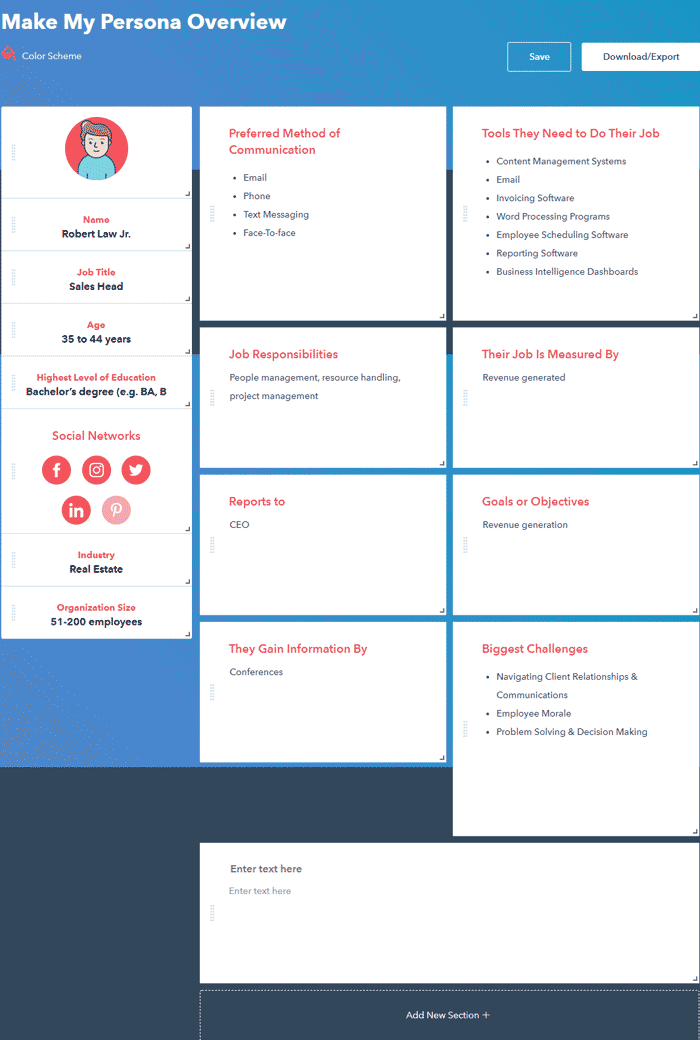
You can branch out to other personas as you progress to other segments of your targeted audience.
3. Do Your Market Research
Market research involves profiling your competitors and customers. You need to understand where you stand in comparison to your competitors.
If your competitors are active on social media then you too need to do the same. If they are spending on ads then you need to understand why they are doing so.
You have to focus on organic ways of grabbing the attention of your clients. Before you spend money on ads, build a solid foundation of organic content.
Competitor Analysis: Keyword Research
You can keep an eye on your competitors with several tools. Here’re a couple of examples.
Head over to Ahrefs and create a trial account. You can access its free tools as well.
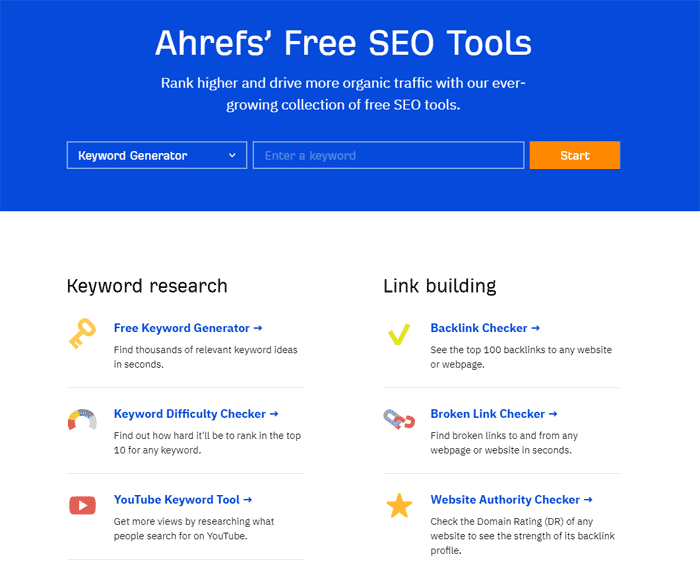
First, select the keyword checker tool and type in industry-relevant keywords. A keyword is any word that your customers type in while searching on the web.
For example, use lawsuits and hit start.

Next, select the medium of search. You can select between Google, Bing, YouTube, and others. For now, I choose Google and also filter the country.

Click Find Keywords.
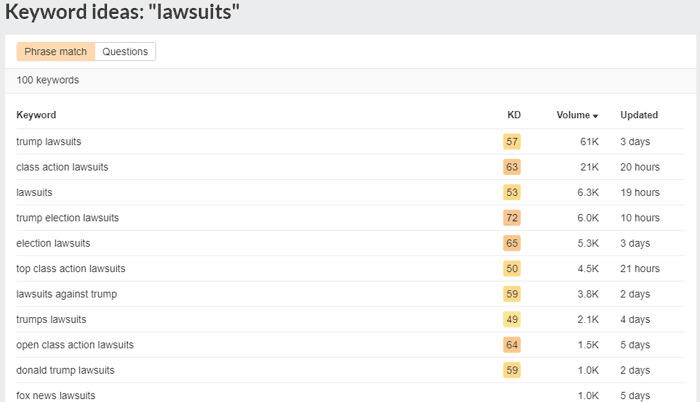
You now have access to 100 keywords related to your niche. If you look at the columns, you have three different parameters.
The first one is KD, which stands for keyword difficulty. You should aim for a KD of >30. The next column is the volume of search that tells you how many times this keyword was searched on Google. The last column is the update.

Next to phrase match, you also have the option to see questions. Click on it to reveal a set of questions that your potential clients are curious about.
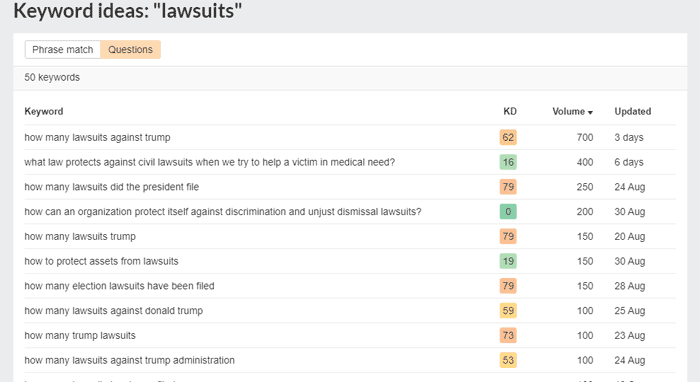
These questions can easily guide you to create great content. You can filter the questions with lower difficulty.
For example, the question “how can an organization protect itself against discrimination and unjust dismissal lawsuits?” has the lowest or nil KD. A fantastic opportunity for you to nail in the head.
Let’s try another tool.
If you want even more questions, you can go to Answer the Public. For the same keyword – lawsuits, you have over 72 questions available.
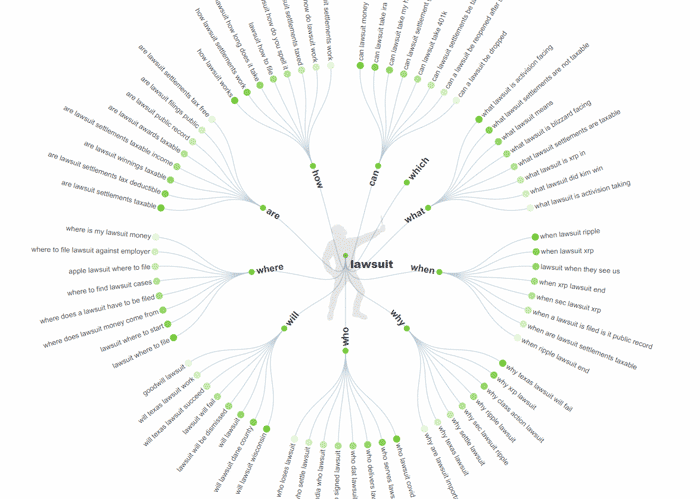
Don’t forget to add the location of your country before you start the search.
Answer the public will not provide you with KD figures for questions. If you need that kind of data, consider a paid plan on Ahrefs or any other tool that can do it.
With the help of the above tactics you now have a knowledge base of questions regarding your industry.
Next, let’s do some more research. In particular, your industry competitors.
Head back to Ahrefs and choose the SERP tool. SERP stands for Search Engine Results Page. This is the page that you see when you are searching on Google.
In the SERP tool type “how to file a lawsuit”. Select your country of interest and hit Check SERP.
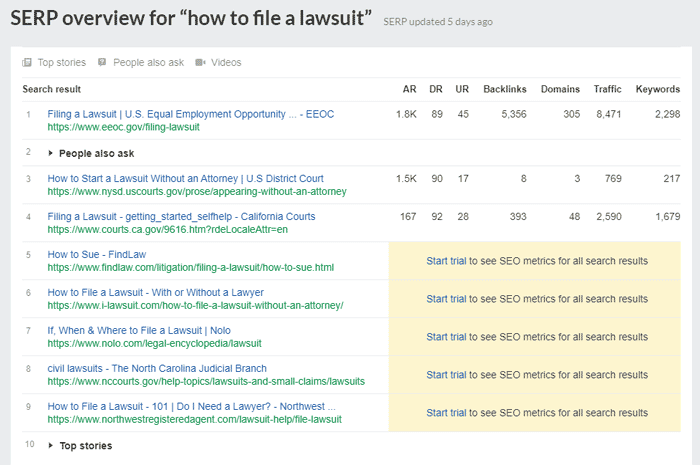
The above screenshot shows the SERP for the search term “how to file a lawsuit”. You can study the rankings and note down the domains or websites that are ranking high for this long-tail keyword.
On the right, you have seven columns. Each parameter has its own importance.
AR – Ahrefs Rank is Ahrefs’ metric for ranking websites.
DR and UR are the main ones that you need to look for. Domain Rating (DR) is domain authority and UR stands for URL Rating. UR is the URL strength for that particular page where the content is posted.
Backlinks are the links that point back to this particular webpage with the keyword.
And lastly, Traffic shows the traction for the keyword — estimated organic traffic that a particular page will receive.
When you’re starting your content marketing journey as a law firm, you need to first target easy keywords. And slowly work your way up to more competitive keywords.
Competitor Analysis: Backlink Checker Tools
Another important tool is backlink checkers. It will help you to gauge the strength of your competitors’ websites.
The more the number of backlinks for a website, the better the rankings, as Google gives higher weightage for quality backlinks.
For example, type in this web address “https://www.rendelmanlaw.com/” in the Ahref Backlink Checker tool.
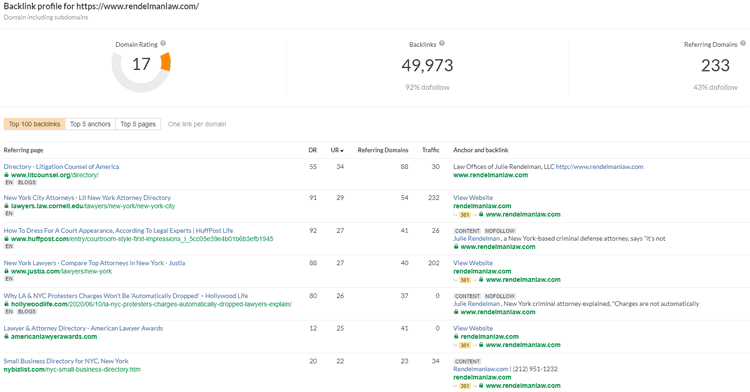
Just look at the third result on the screenshot — you see this website has got a very high-authority backlink from Huffington Post. Awesome!
To find similar websites in your industry head over to Alexa Find Similar Sites. You can search other sites with your own domain or use some other website as well. It will give you a list that you can use in combination with other tools to get a clear picture.
With these data points, you now have a direction to follow. What worked for them can work in your favor too.
4. Create Brand Assets
You can create as much content as you want, but without branding, you’re not standing out. To make your content stick out, you need branding. Create your content keeping in mind what your brand stands for.
You need to deliver a consistent voice and to do that you need to use brand assets. From Facebook posts to Instagram feeds, your branding style guide provides uniformity.
A consistent narrative can only flow from consistent branding throughout the marketing campaign.
If you want to establish your authority, you need your followers to recognize your mark of trust. And what better way to do it than to stamp your brand right in front of everyone.
To create brand assets, all you need is a free website with all the goodies in place. Canva is one such website. There are others too, but Canva has most of the things covered.
With the help of Canva, design and upload your various social media identity graphics. You can easily do that with the tool.
Head over to Canva and start building your brand identity.
Let’s check out an example. We’ll create a simple brand asset in Canva.
First, head over to Canva and create an account. Canva also offers a 30-day free trial.
Once you’re logged in, you can see several options on your left sidebar.
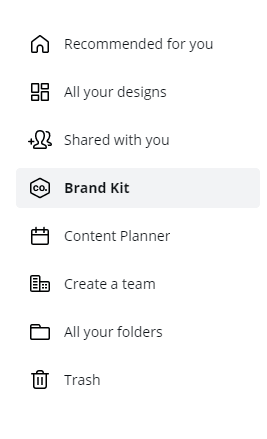
Select brand kit and on the right side, you can see the add brand kit button. Click on it and name your brand kit. For now, we’ll name it “Lawyers’ Brand Kit”.
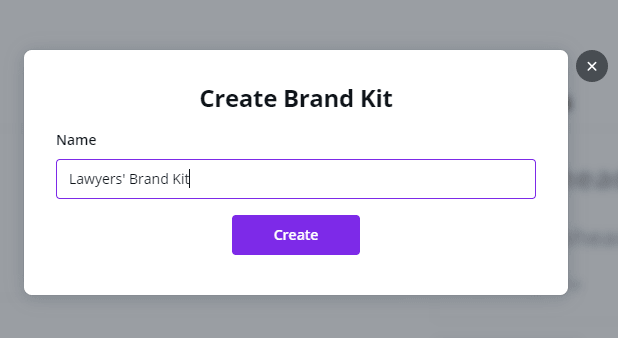
Hit create and start by adding your logo. A transparent background logo in png format is ideal.
Click the big + icon below the brand logo and add your logo. After your logo is added, Canva also automatically adds colors from your brand logo. You can choose to keep these colors or add more to them.
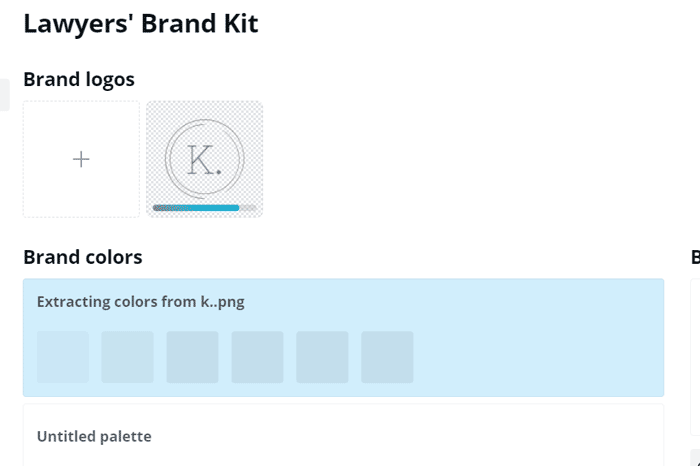
Next, you can also pick and add more colors to your palette. Don’t forget to add the typeface to your brand identity. You can upload custom typography or select from Canva. You can select fonts for different styles separately.
The final page should look something like the screenshot below.
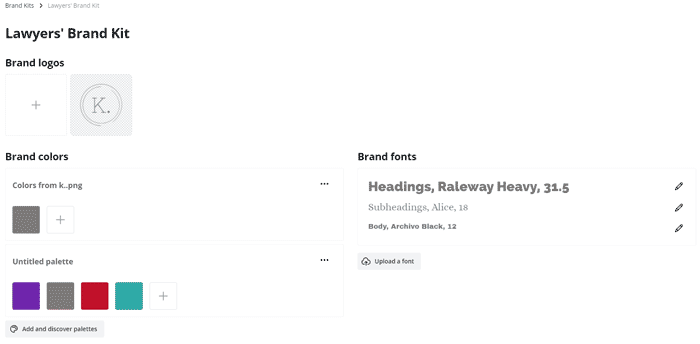
You can now use these settings across your content marketing. From Instagram posts to YouTube videos thumbnails, you’ll post them with a more consistent design system.
Canva also provides you the option of using its inbuilt content planner with scheduling. You can plan with your content pieces and publishing schedule.
You can simply go to the content planner present as an option on the left sidebar of your dashboard and click the + icon to schedule your content for the coming days.
From there you’ll move to the design editor where you can create your post. From the right-hand top corner of your editor page select “schedule” and select the channel of your choice.
Remember that you need to provide Canva with social media account access for scheduling to work.
5. Content Marketing Types
There are several content marketing types but as a lawyer, you need to pick one that suits your industry.
For starters stick with a couple of content marketing types. Let’s check them out one by one.
1) Case Studies: If you want to show an advantage over your competitor law firms, case studies are perfect for it. You can use case studies to highlight the benefits of your law services. With the help of case studies, you can create content that points to the pain points of your focus audience.
Case studies allow you to go in-depth on not just why but how you approach your clients’ cases. Case studies are like examples that make it easy for your customers to make a decision.
Your customers can easily relate to these case studies. This will help you to build trust among your potential clients.
Don’t forget to use your storytelling techniques, while you prepare your case studies.
Keep these points in mind while you prepare your every case study:
1. Who’s your ideal customer? Make use of the persona that you have created.
2. What are your customers’ pain points?
3. How did you resolve your customers’ problems?
4. And what was the end result?
Always create your case studies with real numbers or data. Make it highly readable for even a child.
If you want, you can also divulge some of your strategies in the case studies. All of this will help you create more authority in your space.
2) Infographics: You can also make use of infographics to present your case studies in a highly visualized manner. You can easily create high-quality infographics using Canva.
3) Ebooks: Ebooks are highly used by content marketing professionals to generate awareness and capture leads. Ebooks are nothing but longer content pieces.
The delivery format for an ebook is PDF or Kindle, but you can use other formats as well. Some other formats are Mobi, ePUB, IBA, ODF, etc.
If you are serious about ebooks then you can also publish your ebooks on Kindle. Ebooks are a great way to capture leads in any industry.
You can use Canva to create great-looking ebook covers for your law firm.
4) Videos: Videos have become a prominent content marketing tool. From YouTube videos to Instagram reels, video content has become a prominent content type. Especially after the covid-19 pandemic, there’s a boom in the video content format.
You can create many types of video content. Here’s are the most popular video content types:
1. Vlogs (blogs in videos format)
2. Tutorial videos
3. Video interviews
4. Testimonial video reviews
5. Video ads
6. Live stream videos
In 2020, video marketing has grown 55% compared to 2019. In another survey, by 2021 over 86% of marketers will use video as a marketing tool. (Source)
Apart from creating these content types, you should also experiment with upcoming platforms and content types. What works for others might not work for you, so keep on experimenting.
6. The Process And Distribution Of Content
After you have planned out the type of content for your law firm, the next step is how you’ll distribute it?
For that, there are over 100+ tools in the content marketing arena. These tools work from the ideation phase to the final distribution phase.
You can store your ideas here, create multiple content calendars, and manage to publish as well.
The tool that makes it to the top is DivvyHQ. Other prominent tools are Hubspot, Coschedule, Growthhackers Workflow, and Google.
Some tools have free plans and others are paid. But using any of these tools will exponentially increase your content marketing efficiency.
You can check out the list of top content marketing tools here.
Some of the prominent content promotion techniques are:
1. Social media marketing
2. Link building
3. Email marketing
Social Media Marketing:
You can use social media marketing to gain visibility for your content. Any social media channel such as YouTube, Twitter, or Instagram can provide you with such a platform.
You need to create content with consistency. Repurpose and distribute your content across several social media channels. Engaging content will ensure higher shares by your audience.
Make use of great headlines and eye-popping images for social media content. Also, have a hashtag strategy that can ensure better reach to your potential clients.
You can make use of free tools to create social media-optimized messages. Check out CoSchedule’s social message optimizer.
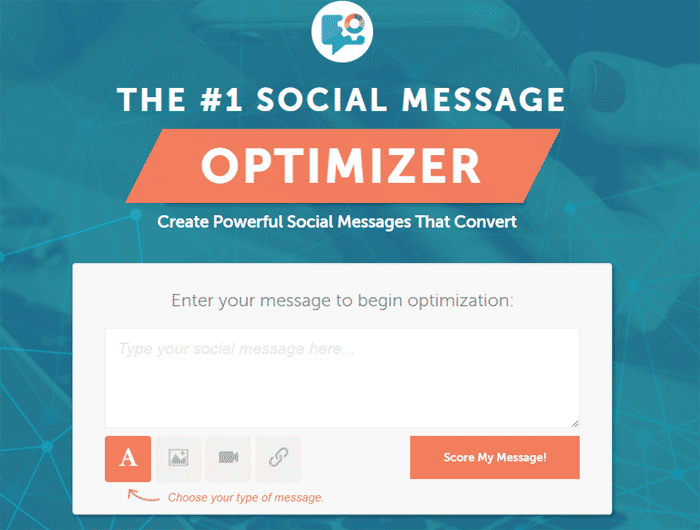
Link Building:
Creating good content is one thing but building quality links is a completely different ball game. Link building is a crucial part of your content marketing strategy. As a law firm, you need to keep adding quality links to every content that you publish on the internet.
There are two types of links. Internal links and external links. Internal links help to navigate within your website. External links take your visitor to another website. If someone links to your content then they are linking externally to your website.
You need people to link to your content regularly. It is a crucial part of SEO rankings as well. The easiest way to gain a backlink to your website is to write a guest blog article on some other website and have a link back to your website.
You need to generate as many ideas as possible to get as many backlinks as you can. Getting reviews for your services and products can also generate backlinks.
You can study and analyze your competitors’ backlink strategies to build your plan. For a thorough backlink strategy, shell out some money for a decent SEO tool. The two most recommended are Ahrefs and Semrush.
Ahrefs generally provides better in terms of searching for organic ways of content marketing. Semrush, meanwhile, is more suited for the PPC (paid per click) type of marketing.
You can choose any one of the two.
By going through your competitors’ backlinks, you’ll gain a deeper understanding of how they build theirs. You can mirror their strategy to have similar results.
Email Marketing:
Emails aren’t outdated. It’s still one of the most prominent ways of communicating and keeping in touch. A lot depends on the open rates of emails, though.
You need to create emails that have a snappy headline, which compels your subscriber to open your emails. You can use a tool such as Headline Analyzer, which can help you to create optimum headlines.

In the marketing world, it’s believed that for every dollar you spend on email marketing you’ll earn around $40. Email marketing is set to increase to $17.9 billion by 2027 (Statista 2021).
There are many tools that you can use for email marketing. One of the prominent ones is Mailchimp. You can also go for cheaper ones such as Sendy. Though, you’ll lose on several features that something like Mailchimp can provide.
Make your emails readable, short, and to the point. Don’t overly promote yourself or your services in your emails to your subscribers. Make your emails scannable.
You can catch emails from your audience by providing them with valuable content. An ebook is a perfect example to gain more email subscribers. Prepare your downloadable ebook for those who subscribe to your email list.
7. Set Goals and Have Industry Specific KPIs
There’s no use of great content if you don’t set goals. Goals that are simple, reasonable, and achievable.
Your goals should speak the language of your firms’ targets. If you’re a small firm with limited resources, you should set goals that are in tune with your team size. Setting goals that are beyond your reach will lead you to nowhere.
Have goals that aren’t too easy or unrealistic. You can challenge yourself and your team for better than expected results. But it should remain within the constraints of the resources that you apply towards your content marketing efforts.
As far as KPI (key performance indicators) goes, every law firm will have specific markers of success. You need to combine your various content tools to understand your law firm’s KPIs. With trial and error, you’ll finally reach a consensus and build reliable KPIs.
Meanwhile, here are the generally used content marketing KPIs:
1. Unique Page Visits: One of the simplest measures of your content marketing strategy’s success is the traffic on your website. You can measure the page visits with the help of Google Analytics. Content marketing should increase the number of page visits over a period of time. If it’s not the case, you should reconsider your content marketing strategy.
2. Bounce Rate: The bounce rate shows the number of visitors leaving your website. A higher bounce rate indicates a weak website. You need to lower the bounce rate on your website.
3. Shares: Shares indicate which of your content and on what platform are performing the best. It can help you to understand what’s working in your favor with the current content marketing strategy.
4. Followers and Subscribers: If you are heavy on email marketing, you should focus more on your subscriptions. Whereas, a higher count of followers is good for those who focus more on social media marketing tactics.
5. Conversion Rates: If your content is not converting into leads then that content is of no use. Every piece that you put on the web should have some impact on your conversion rates. You need to diligently measure your conversions to keep a sharp eye on performance.
6. Inbound Links: Inbound links are a high-priority metric when it comes to Search Engine Optimization. The links on your website affect your rankings on the search page. You should aim for high-quality backlinks to climb the rankings ladder much faster.
There are several other KPIs that you can use for tracking the performance of your content. You can have your in-house metrics that can specifically target a segment of content or strategy.
Conclusion
Hope that the above article has helped you to get started with the content marketing strategy for law firms. This is just the beginning, and don’t forget to add your own twist to the mix of things. Keep experimenting and generate qualified leads through content marketing.
Let us know if you have any content marketing strategy questions. We’ll gladly help you out. Don’t forget to subscribe to our list for more content.
Thank you for reading. Until next time.
Meira Rawel is a Content Marketing Strategist at Web Content Edge. She has over 10 years of experience in content marketing and SEO. With a passion for creating engaging online experiences, Meira is instrumental in developing content marketing strategies for our clients that drive organic traffic, improve user engagement, and increase conversion rates.

